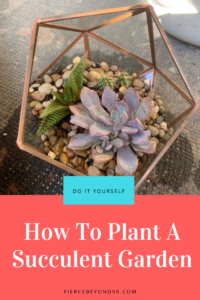This post may contain affiliate links. Full disclosure policy
Succulents are everywhere these days! Oh, wait…You missed the trend? Not sure what I’m talking about? Well, according to Wikipedia succulents are, plant that have some parts that are more than normally thickened and fleshy, usually to retain water in arid climates or soil conditions.”
I think this helps to explain their popularity; they’re pretty hard to kill. I’m not saying it can’t be done but if you’ve got a brown thumb, succulents are perfect for you. But gardeners with thumbs of all colors love succulents because they’re as pretty to look at as they are easy to care for.
You can find whole wreaths made out of succulents, outdoor topiaries shaped like turtles and a myriad of indoor stylings — some with a single plant and others in more of a succulent garden.
I must admit, I’ve been slow to hop on the trend.
That is, until now.
A friend who has styled these playful plants before was set to do some repotting. I asked for an invite and we spent time shopping and potting. Now I’m wondering why I waited so long to get on board. Succulents really are a gardeners dream!
There are so many styles, sizes and colors you can create almost any look you’re desiring. I’m going to focus here on creating a succulent garden, or one container with a grouping of different succulents.
Succulent Gardens Step One: Container Shopping
Your container will determines how many and what shape/size of succulents you will purchase. In this case, we didn’t shop beyond my friend’s house since she was focused on repotting a container she already had. Even if that isn’t your plan, we probably all have a few spare pots or containers laying around. And I’m not exaggerating when I say that almost anything you have can serve as a succulent planter.
Garage sales, estate sales and any thrift store could also be great hunting grounds for adorable containers that can also serve as planters. There really is no limit to what you can use; I’ve seen then planted in old coffee pots, jewelry boxes and hollowed out logs. If it will hold some dirt, you can put a succulent in it.
I feel like there’s a big personal preference between the aesthetics of a clear planter (where you can see some of the layering and depth) versus solid containers. For our succulent gardens I wanted to have one of each to illustrate how different they can look.
These are all some beautiful examples of clear/glass containers that are perfect for succulents:
And here are some examples of solid containers that would look great:
Do pay attention to how large the opening is. One of the containers we used is glass and geometric (very similar to one of the above) and I found it difficult to reach inside with my hands. I’m going to give you advice on tools to use that will help that, but they don’t change the fact you’ll have to get everything inside the opening. Just be aware of that and decide for yourself how well you do with a small opening.
Step Two: Shopping For The Succulents
Now that you have chosen a container (or two!) it’s time to shop for those succulents. The best place is your local garden store or a specialty plant shop, but my local Whole Foods and Home Depot also carry quite a selection of succulents now too.
I won’t offer much advice here, as part of the beauty of succulents are their ability to thrive in many environments. Pay attention to the information on individual plants for their unique characteristics but otherwise: go crazy! Remember the rule of odds in design, which is a pretty self-explanatory way of saying that groupings or clusters look more balanced when there is an odd number. So think three or five (or only one) per pot, not two or four.
And mix those colors and textures! I was dying to put a small cacti in each and since succulents come in so many varieties I also wanted to end up with a shorter, plumper one and a taller, skinnier one for balance.(Technically, catci are not part of the succulent family but they also do well in dry conditions and so, for our purposes, I’m counting them as such. They’ll add lots of visual interest to your succulent garden.)
Gather The Supplies
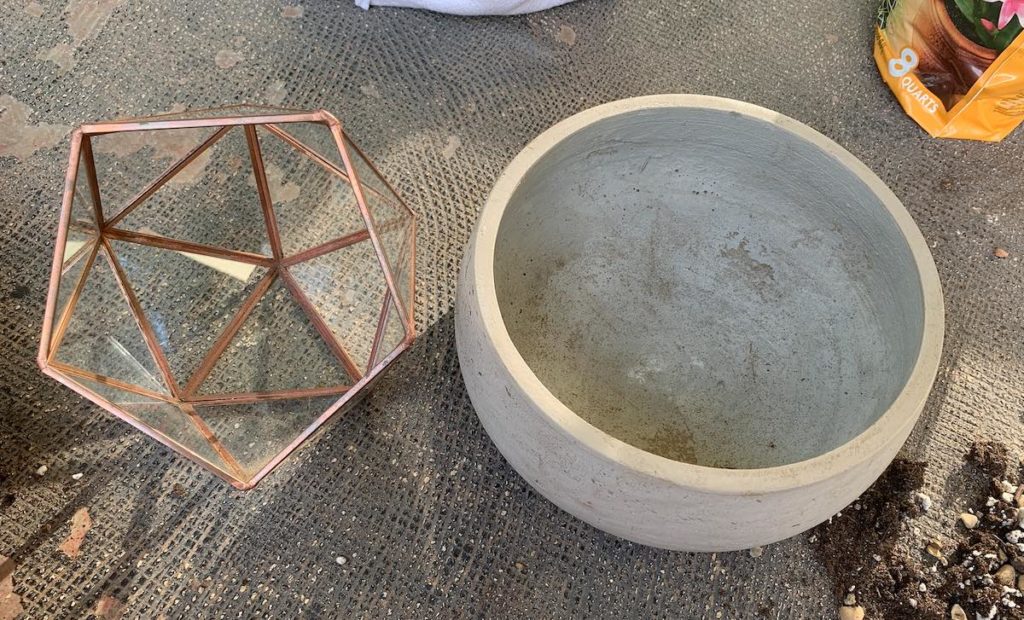
These were the two containers my friend wanted to repot into.
Other supplies we had (but forgot to picture, because we were talking):
- potting soil specifically for succulents or cacti <- this is the kind my friend uses and has worked well for her
- bag of small pebbles
- toothpicks or preferably wooden skewers for moving the dirt/pebbles
- garden gloves if you have a cactus
Get Your Hands Dirty Planting Your Succulent Garden
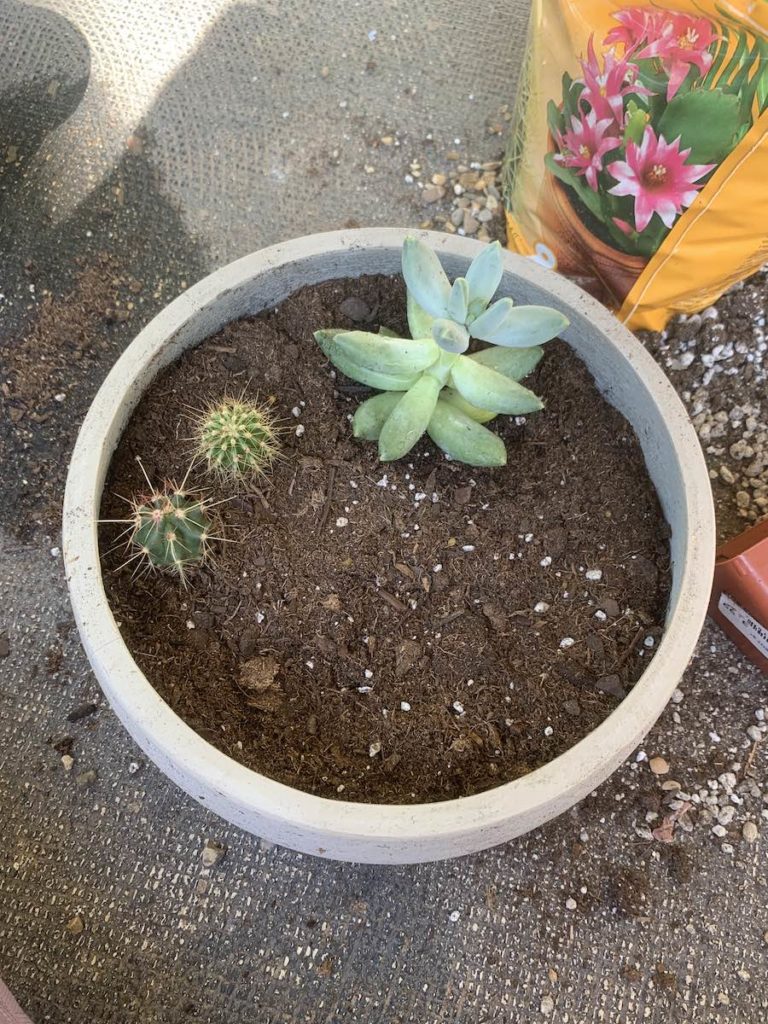
I worked with this container because, frankly, my friend was better at navigating the narrow opening in the glass container.
Many people advise you to put a layer of rock/pebbles on the bottom of your container to allow for drainage. However, my friend recommended using the correct soil and no pebbles. For her, it’s the best combination she’s found in pots like these with no drainage holes.
As I’m a newbie to this I can’t advise one way or the other but I stuck with what my friend recommended regarding soil and no pebbles. The soil you’ll need is potting soil specifically made for cacti or succulents, this is the brand we used but brand matters less that the right type of soil. Succulent potting soil is specially made to dry out sooner than regular potting soil. This cuts down on root rot, one of the more likely demises of your little plant.
Layering Is Key
Whether you place pebbles on the bottom or not, you will definitely want to use them on top. So make sure to leave room for that Just like at the coffee shop when you ask them to leave room for cream in your coffee cup, you don’t want to get to the end and not have room for the last layer. Although spilling out some dirt is less painful than spilling your hot coffee, you get the point. The photo above is a good visual of how much space to leave at the top for pebbles.
When your planter is ready, delicately work those succulents out of their pots, and knock off as much of the container soil as you can. For ease of care at the nursery, most succulents are going to be potted in the wrong soil. It’s fine for them temporarily, but long term the more of the soil you can get off the better.
Decide where you want your new friend to live in your container, burrow out a little hole and plant it! Use that toothpick or skewer to gently work soil in the hole around the roots, getting as much soil as far down in the roots as you can. Succulent potting soil is pretty fine and very compact-able. You want a lot of soil in the pot because once it gets wet it will ‘shrink’ a bit.
Keep working until you’ve got all the succulents down into the soil and planted as firmly as you can. If needed, spray some water from a spray bottle near the base to help compacting the soil so you aren’t left with an unstable plant.
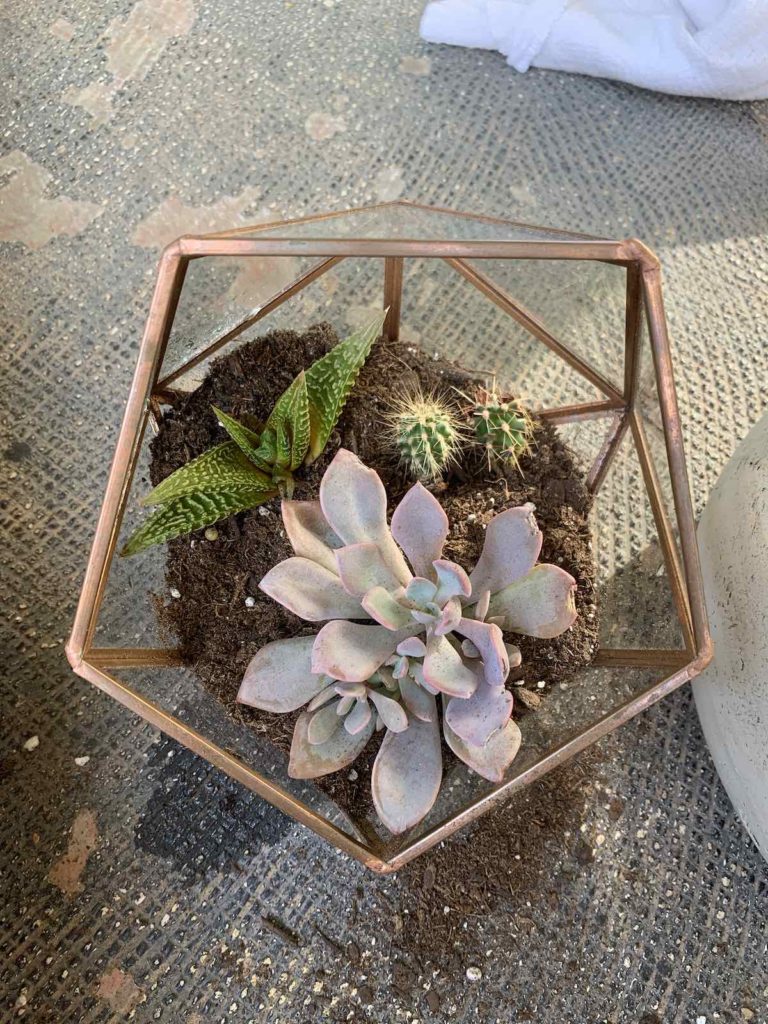
This was that succulent garden my friend worked on, and it looks fantastic!
I know what you’re thinking: Marie, you said keep things in odd numbers. And yes, you have an eagle eye and listen well! But those two teeny cacti are small and are grouped together which makes them function as ‘one’ for this purpose. If you look above and don’t count but glance, you would agree there are three pieces in this garden.
Finishing Touches For Succulent Gardens
Now for the icing on the cake; the pebbles! They serve a purpose other than just covering the dirt. Just like mulch on top of your outdoor beds, pebbles help the soil retain the moisture. It’s important that the soil hold onto the water long enough to give the little succulents to suck it all up!
Here are our mostly finished succulent garden! Cute, right?
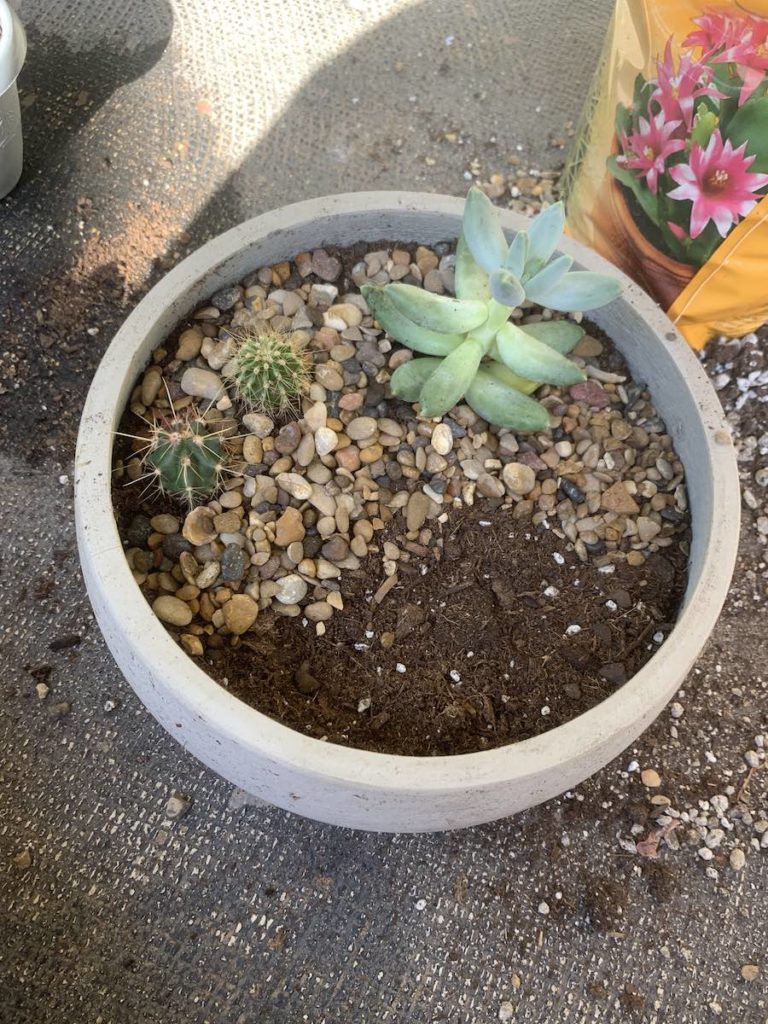

The Aftermath
I’m going to let you in on a secret. Though succulents are very sturdy little guys, sometimes you’ll experience a casualty. (Hey, we’ve all got to go sometime.).
The good news about planting a container garden like this is that repairing and replacing is easy. If you lose one of your little plants just pull it out (roots and all) and find a new succulent that will like that home. These guys are easy to care for but over time you’ll eventually lose one here or there. It happens to even the greenest (or brownest) of thumbs.
You’re not going to need a lot of advice on succulent care but resist the urge to water frequently; less is definitely more with these type of plants. But who doesn’t love a plant that keeps living with only a little bit of loving?
Want more planting / greenery / flower advice? Check out some outdoor planting tips or my guide to making your own floral arrangements.
THIS POST MAY CONTAIN REFERRAL LINKS. IF YOU CLICK THROUGH AND TAKE ACTION, I MAY BE COMPENSATED, AT NO ADDITIONAL COST TO YOU.








